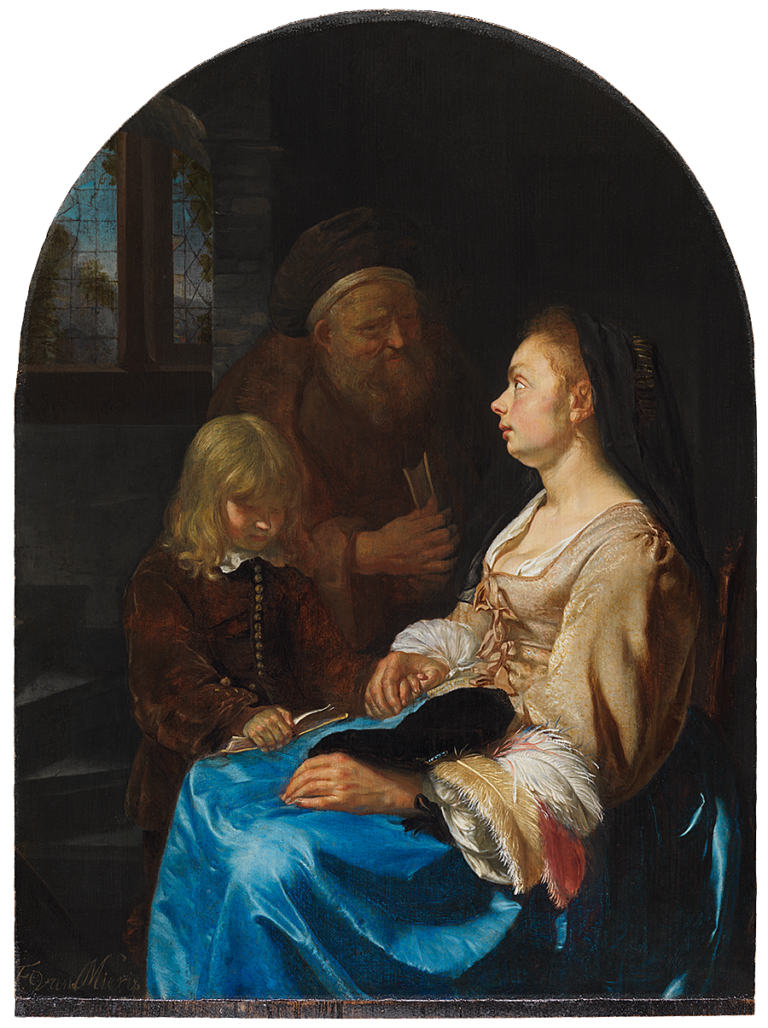Child’s Lesson is one of Frans van Mieris’s early works, probably painted around 1657.1 In this evocative painting, a young mother tenderly holding her son’s hand looks up at a kindly old man holding a book close to his side. Van Mieris situated the three figures in a darkened interior before a brick arch. The dim light passing through the leaded-glass windows in a back room reveals a wooden flight of steps winding to the left, but all of the visual attention rests on the three figures. The attractive woman, who wears a black headscarf, is dressed fashionably in a bluish-purple skirt and a gold-colored upper garment with décolletage.2 Her blond son, dressed in a buttoned jerkin, has laid the book he is reading on his mother’s lap beside his plumed cap. The refined rendering of these garments and feathers displays the Leiden artist’s great virtuosity even at this early period of his career.3
Depictions of women and children in domestic interiors are frequently found in Dutch art.4 The most direct prototype for Child’s Lesson is an engaging painting by Gerard ter Borch (1617–81), The Reading Lesson, ca. 1652 (fig 1), which is one of a number of Ter Borch’s paintings that inspired Van Mieris at various stages of his career.5 In both paintings the mother is seen in profile while her son, with long flowing locks, reads from a book in her lap. As in this instance, Ter Borch seems to have helped Van Mieris develop his narrative style to convey a sense of emotional intimacy between figures, which would become a hallmark of his mature style.
The motif of a mother teaching her children is rooted in allegorical images of Grammar, one of the seven liberal arts.6 Sixteenth-century prints, such as those made by Cornelis Drebbel after Hendrick Goltzius (1558–1617) (fig 2), helped spread this motif to Dutch painters, who translated it into a more contemporary context.8 As in Drebbel’s print after Goltzius, a man is present in Van Mieris’s Child’s Lesson. With his advanced years, beard, brown coat and book, he exhibits all the characteristics of a scholar. Perhaps he is a teacher who has come to give the boy extra instruction and is smiling approvingly because he has found the mother giving her son reading lessons. The elderly man also serves a visual counterpoint to the elegant mother, with her smooth skin, and her young son, providing the artist the opportunity to contrast the differing ages of the three figures.
Van Mieris’s painting has, with good reason, been linked to the Old Testament story of Hannah (I Samuel 1:24–28). Hannah was not able to conceive a child until she had prayed for a son and promised to relinquish him to the priesthood. It has been argued that Van Mieris depicted the moment at which Hannah entrusted her son Samuel into the care of the high priest Eli.9 This interpretation would certainly explain the meaningful gaze exchanged between the woman and the old man, as well as his attire, which seems to be rather old-fashioned.
Van Mieris did occasionally paint history scenes in his later years, such as Death of Lucretia from 1679 (see FM-103). Much like his friend Jan Steen (1625/26–79), he often situated these scenes in seventeenth-century domestic settings, as in his Jeroboam’s Wife with the Prophet Ahijah, 1671, a scene from the Old Testament (fig 3).10 Even though Van Mieris did not situate the figures in a temple, as did other painters from the Dutch Golden Age who portrayed Hannah entrusting her son Samuel to Eli, it is likely that the Leiden master was inspired by this biblical story in rendering this intimate scene.11
